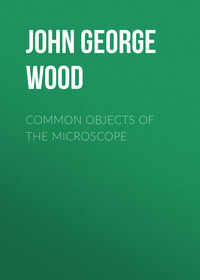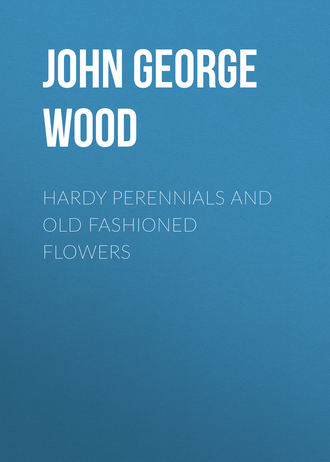
Hardy Perennials and Old Fashioned Flowers
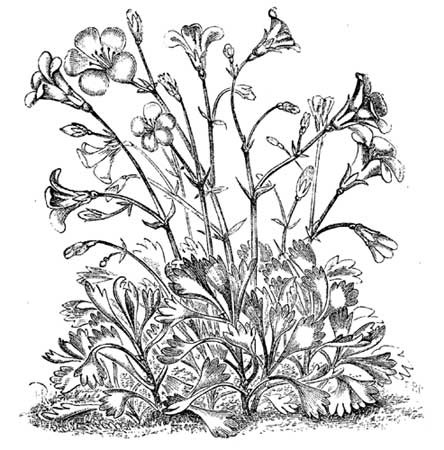
Fig. 93. Saxifraga Wallacei.
(One-half natural size.)
To increase this Saxifrage is a simple matter during the warm season: The twiggy tufts should be pulled asunder, no matter whether they have roots or no roots; if dibbled into fine soil, deeply dug, and shaded for a week or two, they will form strong plants before the winter sets in.
Flowering period, April to August.
Scilla Campanulata
Bell-flowered Scilla or Bluebell; Nat. Ord. LiliaceæA hardy bulbous perennial, introduced from Spain 200 years ago. It very much resembles the English hyacinth—H. nutans, or Scilla non-scripta—better known as the wood hyacinth. Handsome as this simple flower is, it might have been omitted from these notes as a plant too well known, but for the fact that there are several varieties of the species which are less known, very beautiful, and deliciously fragrant, entitling them to a place amongst other choice flowers, both in books and gardens.
Of the typical form little need be said by way of description. The flowers are bell-shaped, pendent, blue, and produced in racemes of many flowers. The leaves are lance-shaped, prostrate, and of a dark shining green colour.
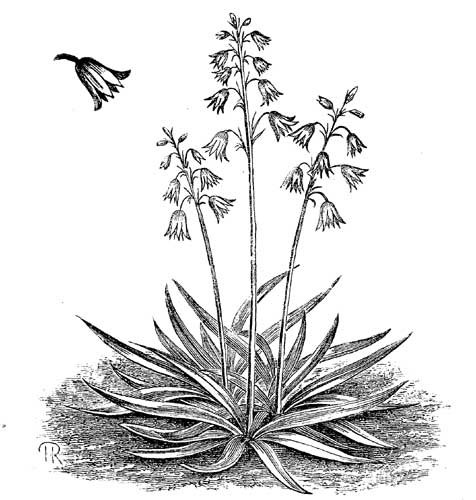
Fig. 94. Scilla Campanulata Alba.
(One-fourth natural size; single flower, one-half natural size.)
S. c. alba differs from the type in having its white flowers arranged more evenly round the scape, being shorter in the divisions of petals and wider at the corolla; the habit of the plant, too, as may be seen by the illustration (Fig. 94), is more rigid and neat. In a cut state the flowers are not only very lasting, but if gathered clean, they are suitable for the most delicate wreath or bouquet.
S. c. carnea has pink flowers.
All the forms of S. campanulata are cheerful and effective spring flowers. They should be grown in bold clumps, and if under slight shade, where many other things cannot be well grown, all the better; still, they are in no way particular—any aspect, position, or soil will answer for these robust flowers. Such being the case, few gardens should be without at least the finer forms of the large Bluebell. So fast do these varieties increase by seed and otherwise, that any remarks on their propagation are unnecessary.
Flowering period, April to June.
Sedum Sieboldi
Siebold's Stonecrop; Nat. Ord. CrassulaceæThis is a capital species. It is perfectly hardy, though not generally known to be so. It is more often seen under glass, and is certainly a pretty pot plant.
Its stems are 12in. or less in length, slender and procumbent. The leaves, which are rather larger than a shilling, fleshy, cupped, and glaucous, are curiously arranged on the stems, somewhat reflexed, and otherwise twisted at their axils, presenting a flattened but pleasing appearance. The small flowers, which are bright rose, are borne in clusters, and remain two or three weeks in perfection.
It is a fine subject for rockwork, and, moreover, likes such dry situations as only rockwork affords. It should be so planted that its graceful stems can fall over the stones. There is a variety of this species, with creamy foliage, but it is less vigorous; neither are the flowers so fine in colour. Slugs are fond of these, and sometimes they will eat off nearly every leaf. A sprinkling of sharp sand once a week keeps them off, but trapping them with hollowed turnips is a more effective remedy. Propagated by cuttings pricked into sand in summer, or division of roots when the tops have died down.
Flowering period, August and September.
Sedum Spectabile
Showy Stonecrop; Nat. Ord. CrassulaceæHardy and herbaceous. This is one of our finest autumn bloomers. During September, the broad massive heads of small rosy flowers, which are arranged in cymes 6in. across, are very attractive, and will, with average weather, keep in good form for a month. This species is somewhat mixed up with another called S. Fabarium; by many they are said to be identical, but such is not the case. I grow them side by side, and I may say that they are as "like as two peas" up to midsummer, when they begin to diverge. S. Fabarium continues to grow to the height, or rather length, of 2ft., and tumbles over; the foliage has a lax appearance, and the flowers are very pale. Concurrently S. spectabile has grown its stems and glaucous leaves to stouter proportions, and crowned them with more massive heads of bright rose-coloured flowers, at the height of 15in. It is larger in all its parts, with the exception of length of stem, and by September it is nearly twice the size of S. Fabarium; it also stands erect, so that then the two species suggest a contrast rather than a comparison, S. spectabile being by far the more desirable.
I find, however, that it is much slower in increasing itself; the best way to propagate it is by cuttings dibbled into sand in early summer. The commoner one increases rapidly and often bears the wrong name; care should therefore be taken to obtain the true species, after which it will not give much further trouble, thriving in any kind of soil, but it should be planted in the full sunshine, when its habit and flowers will be greatly improved. It will bear any amount of drought—indeed, it seems to enjoy it. My finest clump is on a very dry part of rockwork, where it has always flowered well. These two Stonecrops and a variegated variety are some of the very few hardy plants which slugs do not graze; at any rate, it is so with me; neither do other pests attack them, but the humble bees literally cover their flowers the whole day long at times.
Flowering period, August to October.
Sempervivum Laggeri
Lagger's Houseleek; Nat. Ord. CrassulaceæOf the numerous species and varieties of Houseleek, this is at once the most curious, interesting, and beautiful. It is by far the finest of the webbed forms. It has, however, the reputation of not being quite hardy, but that it will endure our severest winters is without doubt, and if we recall its habitats, which are in alpine regions, its hardiness in a low temperature need not be further questioned. Still, partly from its downy nature, and partly from the dampness of our winters, this climate causes it to rot. There are, however, simple and most efficient remedies, which shall be mentioned shortly.
The illustration (Fig. 95) gives some idea of its form and habit. The flowering rosettes send up stems 6in. high; they are well furnished with leaves—in fact, they are the rosettes elongated; they terminate with a cluster of buds and flowers, which remain several weeks in perfection, however unfavourable the weather may be.
The flowers are more than an inch across, of a bright rose colour, and very beautiful; the central flower is invariably the largest, and the number of petals varies from six to twelve. The leaves are in rosette form, the rosettes being sometimes 2in. across, nearly flat, and slightly dipped in the centre; a downy web, as fine as a cobweb, covers the rosette, it being attached to the tips of the leaves, and in the middle it is so dense that it has a matted appearance. The leaves are very fleshy, glandular, and of a pale green colour. Slow in growth, habit very compact; it has a tender appearance, but I never saw its web damaged by rain or hail.
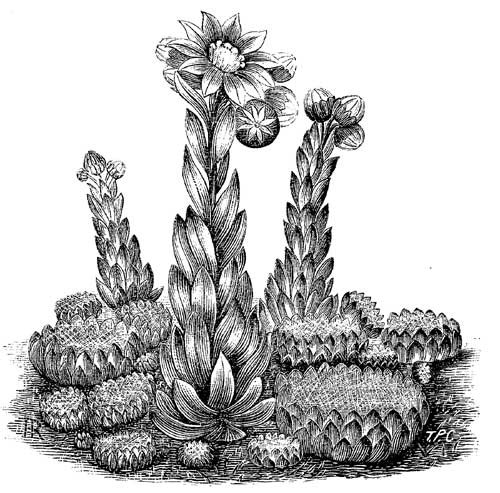
Fig. 95. Sempervivum Laggeri.
(Two-thirds natural size.)
Many grow it in pots for indoor use; it finds a happy home on rockwork or old walls; it should have a dry and sunny situation, and, with these conditions, it will prove attractive all the year round. It thrives well in gritty loam; a little peat rubbed in with the grit will be an improvement and also more resemble its native soil. To preserve it from the bad effects of our damp winters, it need not be taken indoors, but sheets of glass should be tilted over the specimens during the short days, when they are dormant; the glass should not touch the plant. This seems to be the nearest condition we can afford it as a substitute for the snows of its mountain home, and I may add, for years it has proved effective; in fact, for several years I have left specimens in the open without any shelter whatever, and the percentage of loss has been very low, though the seasons were trying. It propagates itself freely by offsets; if it is intended to remove them from the parent plant, it should be done early in summer, so that they may become established before winter, otherwise the frosts will lift them out of position.
Flowering period, June to August.
Senecio Pulcher
Noble Groundsel; Nat. Ord. Compositæ
Fig. 96. Senecio Pulcher.
(One-tenth natural size.)
Autumn is the heyday of Composite flowers. The one now under notice has the merit of being of an unusual and beautiful colour, viz., purplish crimson. It is, in fact, a new plant in English gardens, and has been justly described as one of the finest imports of recent years; it has only to be seen in order to commend itself to all lovers of hardy flowers (see Fig. 96). It is a robust grower, ranking with the more noble subjects suitable for the borders. Its hardiness is doubted by many, and a few have suspected its perennial quality; but notwithstanding the warm climate of South America (whence it hails), it has proved both hardy and perennial in this country. Excessive moisture is its greatest enemy.
Its bright purplish-crimson flowers are daisy-shaped and large, the centre being a fine golden yellow—on strong young plants the flowers will be 3in. across. Moreover, they are numerously produced on stems 3ft. high, in branching cymes, and last a long time in perfection; with favourable weather an individual bloom will stand above a week, and the plant provides itself with abundance of buds for succession. I never yet saw a specimen that developed half its buds, but this brings me to notice one of its faults (for it has more than one), viz., it is too late in blooming; at any rate, in Yorkshire we rarely get more than three weeks' enjoyment of its flowers, when, but for severe frosts, it appears capable of blooming for two months. To some extent this may be remedied, as will be shown when I refer to its culture. The radical leaves are over a foot long, stem leaves much smaller, very dark holly green of leather-like substance, the edges very unevenly shaped, the general form of the leaf being something like the cos lettuce.
The cut blooms are indeed fine and cannot well be inappropriately used. This brings me to fault No. 2. The flower stems are very hollow and dry, nearly as much so as the hemlock or kex, and I have found that when flowers have been cut, either from the moisture collecting in the stem, or some such cause, rot sets in lower down, and soon the branches of bloom head over. I tried cutting to a joint where the cavity was stopped, but the pith when so exposed soon gave way, so that latterly I have ceased to cut the flowers, unless the occasion was worth the risk. A specimen not cut from did not suffer from stem rot. I, therefore, blamed the cutting. There may, however, be other causes; at any rate, there is the fact of fine flowers in their prime falling over, and it is worth one's while to try to find out from what cause it happens, and if my theory is not the true one, it may prove useful as a hint.
It likes a deep and rich soil, and well deserves to have it; if left out all the winter, a piece of glass should be put over the crown, because it has the fault (No. 3) of rotting in the centre, as I believe from water being conducted down its spout-like stems; but even under the most neglected conditions it stands our winters, and the rootlets send up a number of small growths in spring. These may make plants, but will not be reliable for bloom the following autumn; the damage should be prevented if possible. Another plan, by which two points are gained, is to grow young plants in good-sized pots and winter them, plunged in cold frames, not failing to give plenty of air. In April these, if compared with others in the open garden, will be found to be much more forward, and the first gain will be that, if planted out then, they will flower much more vigorously, and, secondly, they will start earlier by two weeks at least. To propagate this fine border plant, the very long and fleshy roots may be cut into pieces 6in. long and dibbled into fine soil; they are somewhat slow, but pretty sure to "go"; they should be protected from slugs, which are very fond of the young leaves. On young stuff, grown apart from the flower beds and borders, quicklime may be used, which would otherwise be unsightly.
Flowering period, August to October.
Sisyrinchium Grandiflorum
Satin-Flower, or Rush Lily; Nat. Ord. Iridaceæ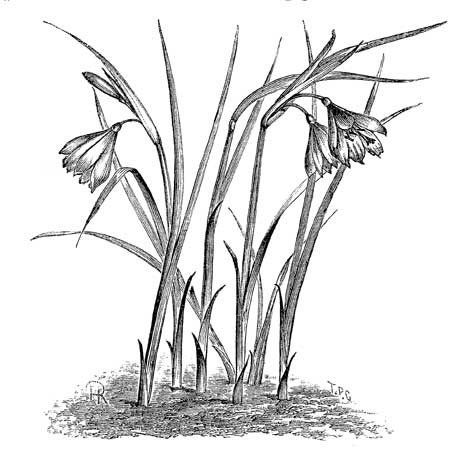
Fig. 97. Sisyrinchium Grandiflorum.
(One-third natural size.)
The generic name of this flower is in reference to the grubbing of swine for its roots, and means "pig-snout." The common names may be seen, by a glance at the cut (Fig. 97), to be most appropriate; that of Satin-flower is of American origin the plant being a native of Oregon, and is in reference to its rich satiny blossom; that of Rush-lily, which is, perhaps, an even more suitable name, has been recently applied to it, I believe, in this country. It is applicable alike to the rush-like form and habit of foliage, and the lily-like purity and style of flowers. It was sent to this country in 1826, and yet it is rarely met with in English gardens. Some think it scarcely hardy in our climate in certain soils. I happen to have grown it for six years, which period includes the recent severe winters, and it has not only survived but increased in a moderate degree. This took place on rockwork facing south; in the autumn of 1881 I divided the specimen, and planted a part of it in the coldest part of my garden, which is not without clay, though far from all clay; that division is now a strong plant, and has made an extra crown; it forms the subject of the present illustration. Let me state, in passing, that it is naturally a slow grower. The very severe weather of the week previous to my writing this note, in March, 1883, when 23deg. of frost was registered, which cut down the bloom stems of Hellebores and many other well-known hardy things, did not hurt this subject very much; I am, therefore, confident of its hardiness from six years of such experience.
The flowers are 1in. to 1½in. long, and about as much across when open, of a fine purple colour, with a shining satiny appearance; the six transparent petal-like divisions are of uneven form, having short bluntish points; from the openness of the corolla the stamens and style are well exposed, and they are very beautiful. The flowers are produced when the plant is about 6in. or 9in. high, the buds being developed on a rush-like stem, and enfolded in an almost invisible sheath 2in. or 3in. from the apex. Gradually the sheath, from becoming swollen, attracts notice, and during sunshine it will suddenly burst and let fall its precious contents—a pair of beautiful flowers—which dangle on slender arching pedicels, springing from the sheath-socket. They seem to enjoy their new-born freedom, and flutter in the March wind like tethered butterflies. Their happy day, however, is soon over; their fugacious petals shrivel in three or four days. The leaves are rush-like, ribbed, and sheathed.
I have found it to thrive in loam, both light and moderately stiff, also in vegetable soil and sand; it likes moisture, but not of a stagnant character; between large stones, at the base of rockwork, suits it in every way; it may also be grown by the side of the larger kinds of snowdrops for contrast and effect. Impatient of being disturbed, it is not wisdom to lift it for any purpose, provided it is making progress, or until it has formed strong tufts; when, if it is desirable to increase it, and during early autumn, the long roots should be got well under, and taken out of the ground as entire as possible; from their wiry nature they are then both easily cleared of earth and divided into single crowns; these should be replanted in positions deeply dug, and where they are intended to remain, being carefully arranged without any doubling up. After such pains have been taken with so well-deserving a plant, there will be little to fear for its future, no matter how severe the winter may prove.
S. g. album is a white-flowered variety, of which, however, I have had no experience. Since these lines appeared in serial form, a lady, cultivating a good collection of choice hardy flowers, has informed me that this variety is very fine, and in every way commendable.
Flowering period, March to May, according to positions or climatic conditions.
Soldanellas
Nat. Ord. PrimulaceæDiminutive herbaceous alpine perennials. This genus is small in number of known species as in size of specimens. They are found in very high altitudes in the Tyrol, Switzerland, and Germany; but they are easily managed even in our foggy climate, as is shown by the fact of the various species being grown in all collections of alpines; and, indeed, no collection can be said to be complete without such gems—they are great favourites, as they well deserve to be. They flower in early spring, some with one, and others more than one flower on a stem.
The flowers are very small, broadly bell-shaped, and of a feathery appearance, from the fact of their petals being finely divided. The foliage is also small, nearly round, of good substance, and in all the following species very bright green; the leaf stalks are long and wiry, and form neat and handsome little tufts, independent of the flowers, which, I may add, do not last more than five or six days.
S. alpina, smaller in all its parts, but otherwise much resembling S. montana—has leaves the size of a shilling piece, flowers bright blue, mostly two on a stem.
S. Clusii, from Germany, is smaller than S. alpina; in other respects similar, with the exception of flowers, which are purple.
S. minima (smallest). Very tiny in all its parts, many of its little thick leaves being only ¼in. across; flowers purple, single on the stem, which is only ½in. to 1in. long.
S. montana (Fig. 98) is the largest species of all—leaves the size of a half-crown piece, flowers bright blue, four or five on a stem, 5in. high. It has other distinctions, of a minute character, from the smaller species, but by difference of size alone it may be readily identified.
All the Soldanellas love a vegetable soil, as peat or leaf mould, to which, when under cultivation, a liberal quantity of sand should be added. If grown in pots, they make lovely specimens, and should be plunged in sand and kept moist; but I find my specimens to grow much more vigorously when planted out, as they are at the base of a small rockery, rather below the level of the neighbouring walk, which forms a miniature watershed for the supply of moisture. I also fancy the liverwort, which surrounds them, rather helps them than otherwise. Certain I am, however, that moisture is the great desideratum in the culture of this genus. My difficulty with the planted-out specimens is to keep them from being grazed off by the slugs; a dash of silver sand every day or two has sometimes proved of use. When the Soldanellas once get into proper quarters they make rapid growth; I have divided them most successfully in April and May.

Fig. 98. Soldanella Montana.
(One-half natural size.)
Flowering period, March to May.
Spiræa Palmata
Palm-like Spiræa; Nat. Ord. Rosaceæ
Fig. 99. Spiræa Palmata.
(One-eighth natural size.)
A bold and handsome species from China, imported about sixty years ago. It is perfectly hardy, though, generally grown in pots and under glass. It belongs to the herbaceous section, and I may as well state at once that the Spiræas—more especially the herbaceous kinds—are only decorative when in flower, by which I wish to convey the idea that after they have done flowering, from their abundant foliage, which then begins to turn sere and ragged, they become unsightly if planted in conspicuous parts. Still, their flowers and general habit are both rich and handsome when in their prime, and they are certainly worth growing, especially by those who have large gardens, where they can be planted in large patches in some of the less frequented parts.
S. palmata (Fig. 99) has remarkably bright rosy-crimson flowers; they are of indistinct form unless closely examined. It is, however, a well-known form of flower, or arrangement of flowers, and need not be further described, beyond saying they are in panicles and have a feathery appearance. The leaves, which are 6in. or more across, have long smooth stems, are mostly seven-lobed, the lobes being long, pointed, and unevenly serrated. The size of foliage and height of plants vary very much; if grown in a bog or by the side of a stream, it attains the height of 3ft. to 4ft.; in drier situations I have seen it flower when only 10in. high. The specimen illustrated is about 15in. high.
A light spongy vegetable soil, with plenty of moisture, is the main requirement of most of the Spiræas, and to grow them to perfection little less will do; but a creditable display of bloom may be enjoyed from plants grown in ordinary garden loam, provided the situation is moist. By way of experiment, I planted a dozen roots of this species in an exposed border, drained, and in all respects the same as for the ordinary run of border flowers. They none of them flowered, and scarcely grew; at no time would they be higher than 6in. I wish to make it clear that the Spiræas, and especially S. palmata, cannot be grown and bloomed well without an abundance of moisture at the roots, as I am aware that many have tried and failed with this desirable kind. It should be treated as a bog plant, then it can scarcely fail to do well. In sunk parts of rockwork, by the walk gutters, by the side of a pond or stream, or (if there is one) in the hedge dyke, are all suitable places for this bright flower, and if only for the fine spikes which it produces for cutting purposes, it should be grown largely; and as most of the positions indicated are somewhat out of the way, they may perhaps be the more readily thus appropriated. Propagated by division of strong roots during autumn.
Flowering period, July and August.
Spiræa Ulmaria Variegata
Syn. S. Odorata Fol. Var.; Nat. Ord. RosaceæThe beautiful variegated form of the well-known "Meadowsweet," other old names being "Mead-sweet," and "Queen of the Meadows." The typical form, at least, needs no description, it being one of the commonest and most appreciated plants of the British flora. This variety, however, is less known; it differs only as regards the markings of the foliage. When the crimped leaves are young, the broad golden patches are very effective, and when the plants are fully grown, the markings of the older foliage become lighter coloured, but not less rich. Of the value of this as a "fine foliage" plant there can be no doubt; it is very telling, and always admired. As regards its flowers, they ought not to be allowed to develope. I only mention this subject for the sake of its beautifully coloured leaves.
Requirements: Ordinary garden loam, in a moist situation; propagated by root divisions during autumn.
Flowering period, May to August.
Spiræa Venusta






